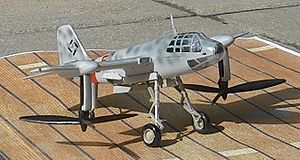| Focke-Achgelis Fa 269 | |
|---|---|

| |
| model shown | |
| Role | VTOL aircraft project |
| Manufacturer | Focke-Achgelis |
| Designer | Heinrich Focke |
| First flight | none |
| Primary user | none |
| Number built | 0 |
The Focke-Achgelis Fa 269 was a tiltrotor VTOL aircraft project designed by Henrich Focke.
Development
[edit]Conceived as a single-seat fighter, the Fa 269 project resulted from a design study order issued by the Reich Air Ministry to Focke-Achgelis in 1941. The order called for a local defence fighter which would combine the VTOL capabilities of a helicopter with the speed and economy of a conventional fixed-wing aircraft.
A large amount of wind tunnel testing was undertaken, along with work on gearboxes, drives and power-pivoting mechanisms, and a full-scale mock-up of the aircraft was built to demonstrate the VTOL concept, but much of this was destroyed by Allied bombing raids and all work was shelved in 1944,[1] when Focke-Achgelis estimated that there was little likelihood of a practical prototype being available before 1947.
Design
[edit]A mid-wing monoplane, the Fa 269 was to have been powered by a single BMW 801 air-cooled radial engine buried in the fuselage behind the cockpit, which was to have driven transverse drive shafts in the leading edges of the fixed wing, the shafts turning three-bladed rotors via synchronised gearboxes. The plane of rotation of the rotors would have been capable of being swivelled through 80° using angled extension shafts.
It was proposed that the Fa 269 would adopt a high angle of attack when at rest using extremely long undercarriage units. For vertical take-off, the rotors would be lowered till their plane of rotation was parallel with the ground. For translation to conventional flight following take-off, the extension shafts were to pivot to the rear, the rotors then behaving as pusher propellers.[2]
Specifications (Fa 269)
[edit]Data from Air International, January 1975
General characteristics
- Crew: 1
- Length: 8.93 m (29 ft 3 in)
- Wingspan: 10 m (32 ft 9 in)
- Powerplant: 1 × BMW 801 14-cylinder radial piston
Performance
- Maximum speed: 570 km/h (354 mph, 308 kn)
Armament
- 2 x 30mm MK 108 cannon
References
[edit]- ^ Lepage, Jean-Denis G.G. (2009). Aircraft of the Luftwaffe, 1935–1945: An Illustrated Guide. Jefferson, NC: McFarland & Company. p. 385. ISBN 978-0-7864-3937-9.
- ^ Ford, Roger (2013). Germany's Secret Weapons of World War II. London, United Kingdom: Amber Books. p. 224. ISBN 9781909160569.
- Springmann, Enno; Gottfried Hilscher (1997). Focke: Flugzeuge und Hubschrauber von Heinrich Focke 1912-1961. Aviatic-Verlag GmbH. ISBN 3-925505-36-9.
- Nowarra, Heinz (1985–1988). Die Deutsche Luftrüstung 1933-1945. Bernard & Graefe. ISBN 3-7637-5464-4.
Well, that’s interesting to know that Psilotum nudum are known as whisk ferns. Psilotum nudum is the commoner species of the two. While the P. flaccidum is a rare species and is found in the tropical islands. Both the species are usually epiphytic in habit and grow upon tree ferns. These species may also be terrestrial and grow in humus or in the crevices of the rocks.
View the detailed Guide of Psilotum nudum: Detailed Study Of Psilotum Nudum (Whisk Fern), Classification, Anatomy, Reproduction